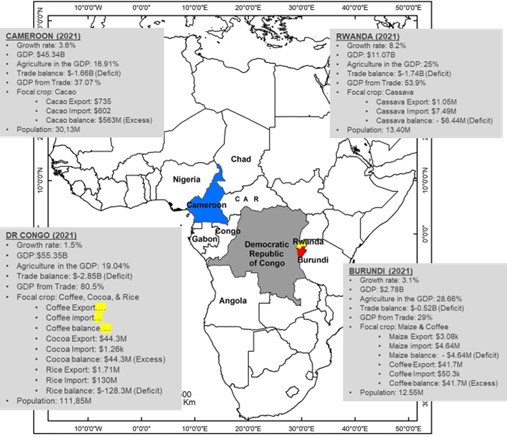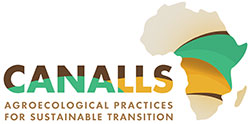The CANALLS project, in which 14 African and 8 European partners will engage in solid multi-actor collaboration and policy dialogues with rural communities, aims to drive Agroecological transitions in the humid tropics of Central and Eastern Africa via multi-actor transdisciplinary Agroecology Living Labs (ALLs).
The first phase of the project commenced with 8 ALLs in 4 Central African countries: Burundi (BR), Cameroon (CR), DRC, and Rwanda (RW), where more than 20,000 farmers and value chain actors co-created and benefited from optimal combinations of agro-ecological practices focusing on crops that are vital for subsistence and economic development (Cocoa, Coffee, Cassava, Rice, Maize).
Living Labs are broadly defined as open, user-centered innovation ecosystems based on a systematic co-creation approach, integrating research and innovation processes in real communities and environments.

Needs, contexts and practices in the project countries.
Burundi
Burundi has two Living Laboratories (LLs), one in Bujumbura and the other in Giheta. Agriculture and livestock breeding are the main activities in Bujumbura, with 45% small-scale farming and 55% medium-scale farming. Here, 75% of households are directly involved in growing maize, the focal crop. In the Giheta living lab, farmers are mainly involved in coffee production, with bananas as a secondary crop.
In Bujumbura and Giheta, farmers recycle farmyard manure and crop residues (Coffee bean husks) and make compost. They reduce inputs by using less mineral fertilizer and using coffee bean husks as organic fertilizer. Farmers face many challenges related to soil health. To overcome these constraints, they use mineral fertilizers, organic matter sources like compost, cover crops and perennial plant species to improve soil health, reduce erosion and promote soil conservation. Different types of livestock are produced, and farmers use a variety of plant and tree species to improve livelihoods, promote diversity and enhance soil conservation.
Extension agents and farmers were trained in agricultural practices for growing corn and coffee. Farmers were also trained in social responsibility, agroforestry, and crop agenda. However, farmers expressed a need for capacity building in disease control, recycling of crop residues, mainly rice husks, irrigation techniques, use of biopesticides, crop association and rotation, soil and animal health. Farmers' knowledge, though limited and not widespread, forms a good basis for the implementation of agroecology in the two ALLs of Bujumbura and Giheta in Burundi.
Cameroon
The ALL is located in Ntui, in the Central region of Cameroon, where 76.7% of the population grows cocoa, while food crops such as corn, cassava and yams account for 3.3%, 16.7% and 3.3% respectively. Various crops help to improve the nutrition of the Ntui ALL population. In terms of economic potential, the Ntui commune is mainly focused on trade and the exploitation of natural resources.
Until the ALL was set up, farmers in Ntui had never heard of agroecology. However, 16% and 5% of households were already practicing recycling, using compost, manure or cow dung and vegetable-based green manures in their farming systems.
Producers from various localities in the council benefited from capacity building in good agricultural practices and integrated soil fertility management (2020-2022). In Ntui, stakeholders also expressed additional needs for capacity building on pollinator use and management, animal nutrition, good breed selection and animal disease management. Group discussions revealed needs in new areas such as recycling, fertilizer production, irrigation, animal husbandry and agroforestry.
DRC
There are four (04) LLs in DRC, in Biega, Bunia, Kabare and Uvira, one of the socio-economic towns in the country. The main land use in Bunia is agriculture, particularly food crops, cocoa and cocoa-based agroforestry. In Kabare, the main crop is coffee. In Uvira, around 54.5% of households focus on paddy rice production, while 36.3% produce cassava, illustrating the importance of agriculture in the region's livelihoods. Agriculture accounts for 65% of the population's economy.
The implications of climate change differ from one living lab to another. In Bunia, extreme events include irregular rainfall, prolonged dry seasons, disease and pests, and sometimes heavy rains that destroy beans and cassava. In Kabare, there is a sharp rise in temperatures, crop pests, landslides, and irregular rainfall, while in Uvira, there is irregular rainfall, extreme drought, landslides, and rising temperatures. A shift in the date of sowing in the agricultural calendar was observed in all the ALLs. Agricultural practices in the living labs are mainly based on traditional methods and indigenous knowledge. This knowledge includes combining crops, ploughing in weeds, crop rotation and irrigation. Farming tools remain rudimentary. Around 50% of farmers in Bunia, 60% in Kabare and 1% in Uvira had heard of agroecology.
Capacity building requirements in terms of recycling capacity, soil health, input use, biological control, biodiversity, and animal health were strongly expressed by farmers in DRC.
Rwanda
With a population of 377,257, the Kamonyi district is home to Rwanda's Living Lab. The diversity of agricultural produce in the district includes cereals and pulses, fruit trees, roots, and tubers. Around 70% of these agricultural products are used for subsistence, but it is also possible to diversify income through non-agricultural activities.
Observed climate changes include higher temperatures during the dry and rainy seasons, reduced rainfall, later and more frequent dry spells, more extreme floods, more severe droughts, and increased winds. Around 92% of farmers have heard of agroecology. Apart from the use of legume-based green manures, which is practiced by only 4% of those surveyed, and the use of reduced tillage and/or no tillage by 30% of those surveyed, the other elements are adopted by 92% to 100% of those surveyed. Around 36% of farmers will reduce chemical inputs to their fields, while 33% are prepared to increase chemical compounds. Around 92% of Kamonyi's farmers expressed the need to acquire knowledge of agroecological practices, build their capacity in agroforestry practices, integrated use of chemical inputs and animal husbandry to optimize the benefits of agroecology. Involving farmers in such knowledge-sharing initiatives will enable them to adapt effectively to climate change.




